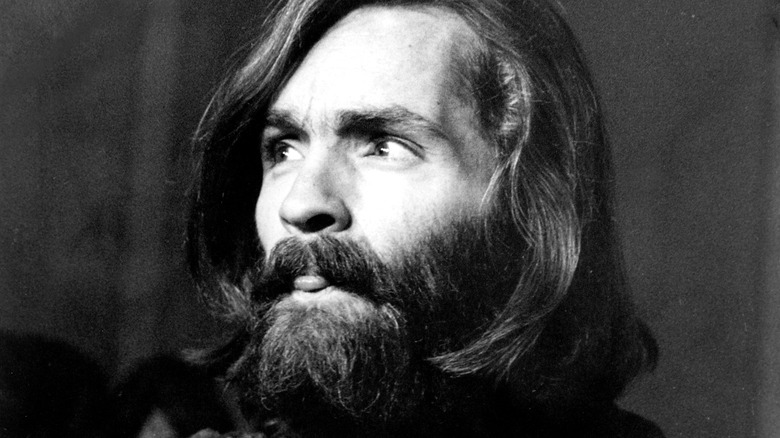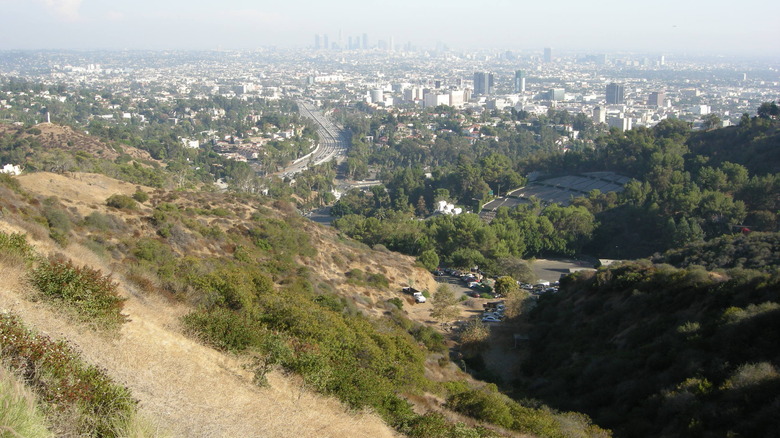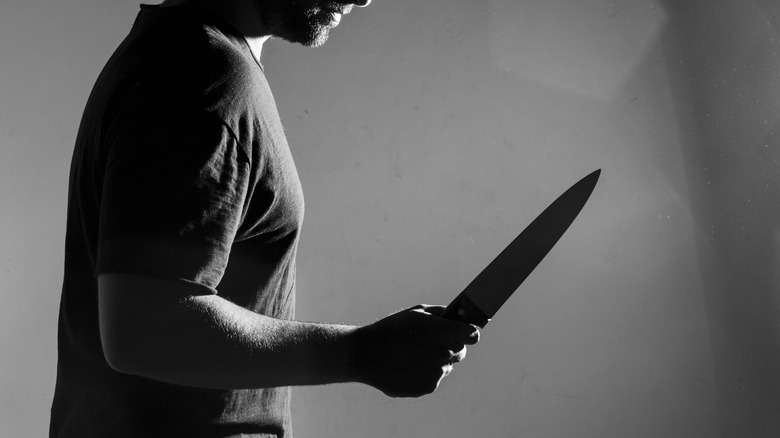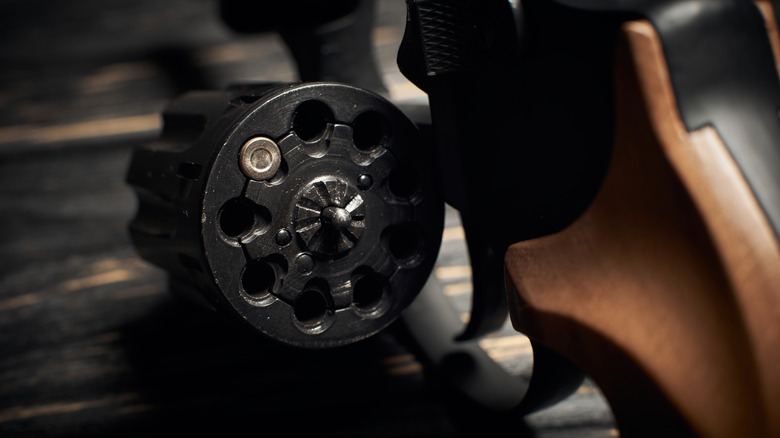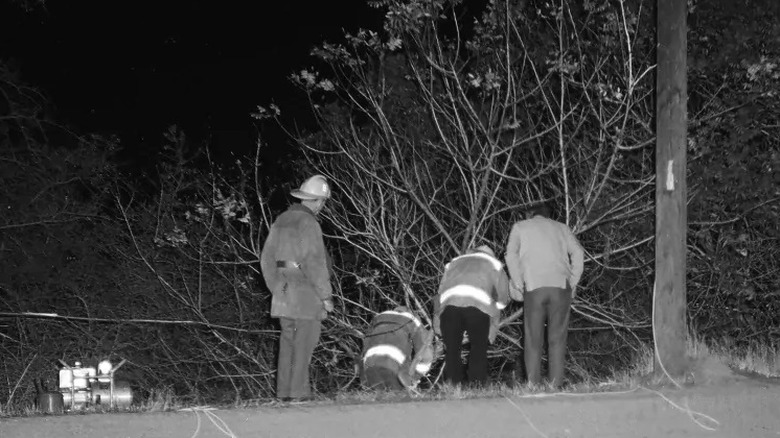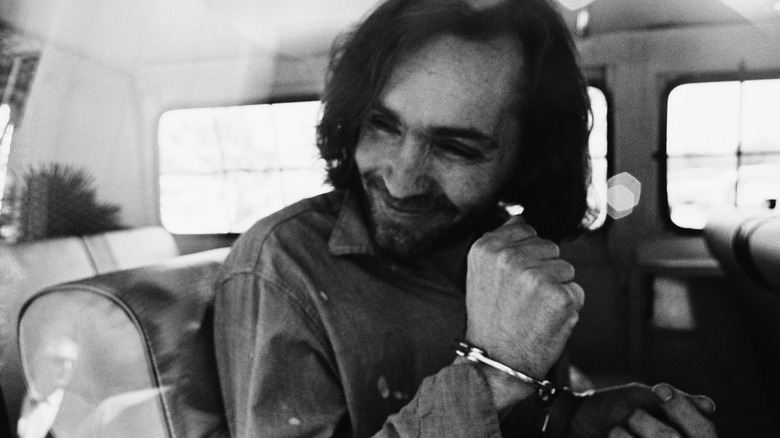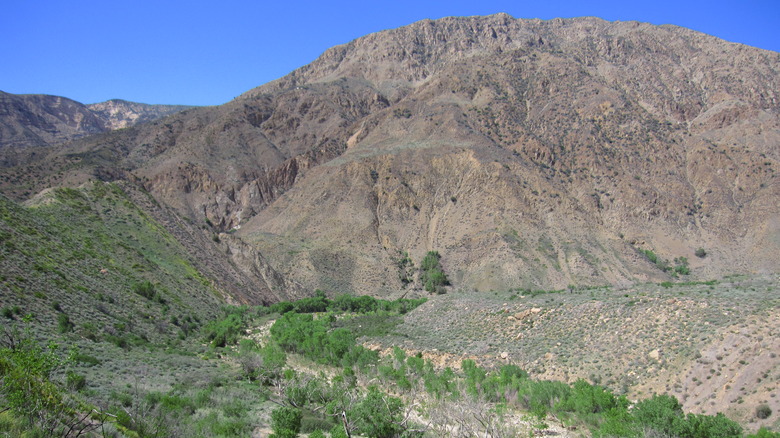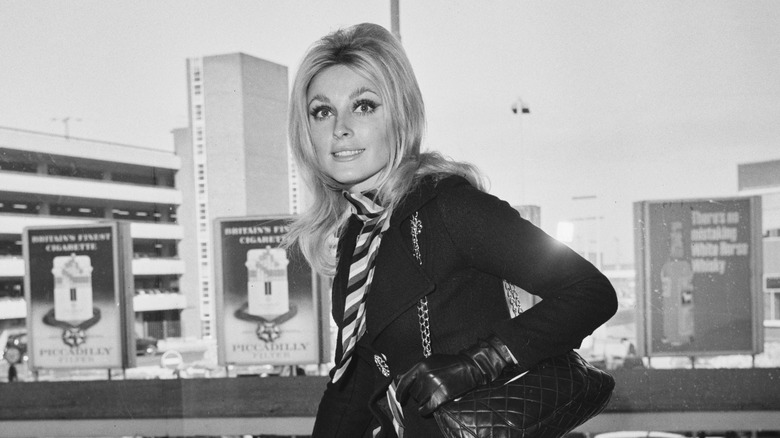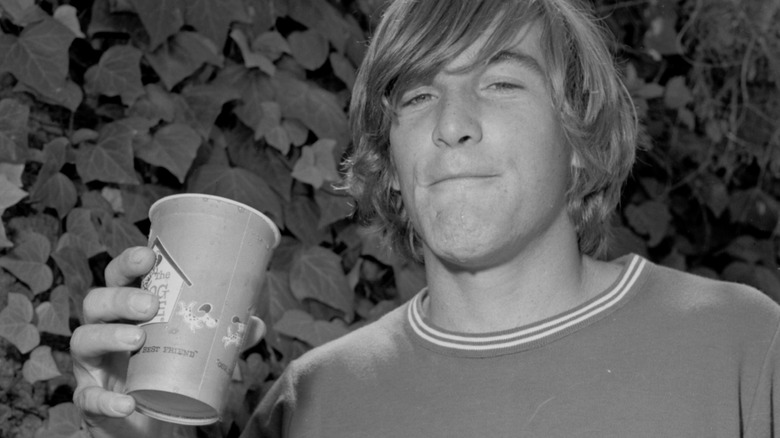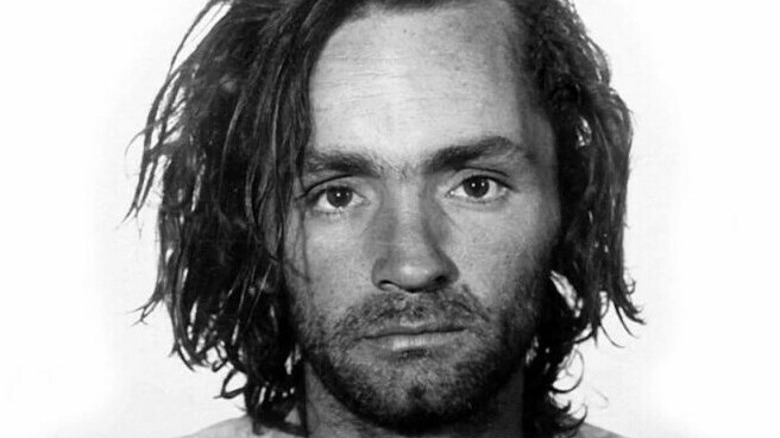The Strangest Mysteries Still Surrounding The Manson Family
Charles Manson and his so-called "Family," a hippie cult and criminal gang that haunted the San Francisco and Los Angeles areas in the late 1960s and early 1970s, are renowned as some of the most notorious killers in American history. Most famous for the murders of actress Sharon Tate and her friends on August 8, 1969, and the randomly selected Leno and Rosemary LaBianca the following night, the Manson cult has piqued the interest of true crime fans across the world in the decades since their gruesome crimes. While ultimately Manson and four of his followers were convicted of the Tate-LaBianca murders, plus the earlier murder of drug dealer Gary Hinman and the later murder of stuntman Donald Shea, many theorists believe these were hardly the only deadly crimes carried out by the Manson Family.
According to a Los Angeles Times interview with Manson prosecutor Stephen Kay, Manson claimed to have been involved in 35 murders. While Kay believes this might have just been a boast from one inmate to another, Los Angeles police have an official list of 12 cold case murder files that they believe Manson might be responsible for in one way or another. Just how many murders did Manson and his followers commit? What drove them to their gruesome killing spree in the first place? These and other questions are just some of the many lingering mysteries surrounding the notorious Manson Family.
Did Manson kill Marina Habe?
The body of 17-year-old Marina Habe was discovered on January 1, 1969, in the brush just off of Mulholland Drive in Los Angeles (pictured), after having been kidnapped from the driveway of her home in West Hollywood two days before. Her father was screenwriter Hans Habe, and her mother was actress Eloise Hardt. According to the autopsy, Marina died from multiple stab wounds to her neck and chest, including a cut across her carotid artery. She was completely dressed, and her purse was found nearby with money and credit cards inside, suggesting the motive for her murder was neither sexual assault nor robbery.
The violent nature of the attack and the strange lack of an obvious motive, combined with the location where the body was discovered, has led police and other theorists to suspect a connection to the Manson Family. The bodies of other victims who may be linked to Manson and his followers were also discovered near the place where Marina Habe's body was found, but this is hardly conclusive, as there were a number of active serial killers in Los Angeles in the late 1960s, and Mulholland Drive was an unfortunately common place for killers to dispose of bodies. Additionally, Charles Manson denied knowing Marina Habe, but obviously his word on such matters should not always be trusted.
[Featured image by Sailko via Wikimedia Commons | Cropped and scaled | CC BY-SA 3.0]
Did Manson break parole to kill his uncle?
Charles Manson was born to a 16-year-old sex worker and never knew his biological father, but officially his father was a man named Colonel Walker Scott ("Colonel" was his birth name, not an earned rank). In May 1969, Colonel Scott's brother, Darwin Scott, was found murdered in his Ashland, Kentucky, apartment. Scott, age 64, had been stabbed 19 times in the chest with a kitchen knife. He had previously been imprisoned for breaking and entering as well as forgery charges.
When it became known in town that Scott was the biological uncle of the now-notorious Charles Manson following Manson's arrest for the Tate-LaBianca murders, citizens of Ashland began to claim they had seen someone resembling Manson — or at least a hippie on a motorcycle — riding through town at the time of Scott's murder. Due to these possible Manson sightings, local police shipped all the fingerprint evidence they had to the LAPD, but this evidence didn't point to Manson or any of his followers. Additionally, in his book "Helter Skelter," Manson prosecutor Vincent Bugliosi states that Manson was on parole in California at the time of Scott's murder and so had most likely not left the state, though he also adds that Manson was out of touch with his parole officer at the time or may have even sent one of his followers to Kentucky. Either way, no one has ever been arrested for Darwin Scott's murder.
Was Zero Haught's death really an accident?
John "Zero" Haught was a 22-year-old member of the Manson Family who was originally from Ohio, but who had moved to California and been introduced to Charles Manson in 1969. Haught was among the Family members arrested during the October 1969 raid on Spahn Ranch following the Tate-LaBianca murders in August. On November 5 of that year, however, Haught was spending time with a number of other Family members — including, notably, Bruce M. Davis, who had played a part in the murder of Donald Shea on August 26. According to the official version of events, Haught found a revolver in the room and thought it would be fun to play Russian roulette. He picked up the gun, put it to his head, and immediately shot himself. Haught's death was officially ruled a suicide.
However, the gun taken from the scene was found not to have had only one bullet in it like you would expect in a game of Russian roulette, but had instead been fully loaded. Additionally, there were no fingerprints found on the gun, and a witness at the scene claimed to have seen a female member of the Family holding a gun when he came into the room. If Haught's death was indeed a murder by other Family members, it's possible that Manson may have ordered it because he suspected Haught had given information to the police — the same reason he told his followers to kill Donald Shea.
Did Bruce Davis kill Doreen Gaul and James Sharp?
On November 5, 1969, the bodies of two teenagers were discovered in an alley in downtown Los Angeles. The victims were 19-year-old Doreen Gaul and 15-year-old James Sharp, both of whom had been members of the Church of Scientology. The two were found to have been beaten and stabbed around 50-60 times each. While these murders have never been definitively solved, since the beginning, Los Angeles police have suspected a connection to the Manson Family.
Besides geographic proximity to the Tate-LaBianca murders, the "overkill" element that is considered characteristic of the Manson Family was definitely in effect, with a police lieutenant describing the stabbings as the work of a "fanatic." Additionally, the fact that the victims were Scientologists led the police to presume a connection: Manson Family member Bruce M. Davis had lived in the same housing complex as Gaul (and may possibly have previously dated her) and had himself once been a Scientologist. Charles Manson was known to have had an interest in Scientology and perhaps the off-shoot splinter group known as the Process Church, which police pursued as a possible connection in what otherwise appeared to be a motiveless crime.
Although a man unrelated to the Manson Family confessed to the police that he had killed Gaul and Sharp as part of a robbery, the LAPD didn't seem convinced and never charged him.
Did Jane Doe 59 witness a Manson Family murder?
Less than two weeks after the bodies of Doreen Gaul and James Sharp were discovered, a birdwatcher came upon the body of a young woman on Mulholland Drive, about six miles from the site of the Tate-LaBianca murders, and very close to the spot where Marina Habe's body was found. The victim had been stabbed over 150 times, but would not be identified for almost 50 years, for decades being known simply as "Jane Doe 59." In 2016, however, the LAPD were able to positively identify the young woman as 19-year-old Reet Jurvetson, a Swedish immigrant to Canada who had only just come to Los Angeles in the fall of 1969. When her family didn't hear from her, they assumed she had simply started a new life in California, never suspecting that something terrible might have happened to her.
Vincent Bugliosi suggested in "Helter Skelter" that the reason Jurvetson was killed was that she had witnessed the murder of Zero Haught earlier in November 1969. The prime piece of physical evidence connecting Jurvetson to the Manson Family is a photo of a woman who looked like Jurvetson dancing at Spahn Ranch with Family member Dennis "Clem" Grogan. However, Manson denied any knowledge of the killing of Jane Doe 59 when police questioned him about it, though his being tight-lipped on such things wasn't uncommon. Grogan, when asked about the photo, said that the woman wasn't Jurvetson, but rather a different Manson follower. Nevertheless, the LAPD believe there may still be a Manson connection.
Did Joel Pugh really die by suicide?
On December 1, 1969, 29-year-old Joel Pugh was found dead in a London hotel room with both his wrists and his throat slashed, and with razor blades and drug paraphernalia nearby. The British authorities concluded that Pugh, who had been depressed and was under the influence of drugs, died by suicide. However, there was no suicide note found on the scene, and some investigators were not convinced. Prosecutor Stephen Kay, for example, argues that while Pugh had no real motive for suicide, there may have been motive for a murder: namely that Pugh was the boyfriend (some say husband) of Manson Family member Sandra Good, and Charles Manson (pictured) hated that the two were romantically involved.
Even though Manson was in jail far away from London when Pugh died, one of his most loyal followers was known to be in London at that time. Bruce Davis — who by 1971 would be found guilty for the murders of Gary Hinman and Donald Shea, and whom some believe to have had some connection with the deaths of John Haught, Doreen Gaul, and James Sharp — was, according to Kay, the Family member most capable of murder, and, by Davis' own admission, eager to please Manson. Additionally, Pugh's room was on the ground floor and could be easily accessed by the window. As a result, Kay and other theorists believe that Manson sent Davis to London to deal with a guy he hated and make it look like a suicide.
What caused the disappearance and death of Ronald Hughes?
Ronald Hughes was a 35-year-old lawyer who had been hired as part of Manson's defense team, specifically to defend Leslie Van Houten, one of the Family members involved in the murders of Leno and Rosemary LaBianca. Although at one point during the trial Hughes was jailed for contempt of court (which also happened to two other Manson lawyers as well), he advocated firmly for Van Houten, to the extent that it seemed like he was throwing Manson under the bus. Obviously this angered Manson, whose final words to Hughes were, "I don't want to see you in this courtroom again," according to prosecutor Stephen Kay. And, perhaps surprising no one at this point, no one ever did. Ronald Hughes disappeared in November 1970, toward the end of the trial.
Hughes had gone camping at Sespe Hot Springs (pictured) during a break in the proceedings, but he didn't return to court when the trial resumed on November 30. His body was found in a creek in Ventura County in March 1971. The Ventura County sheriff believed Hughes' death had nothing to do with Manson, as there were no signs of foul play, saying it was likely the result of a weather-related accident. Vincent Bugliosi says in "Helter Skelter," however, that he believes Manson ordered Hughes' death. In support of this claim, Family member Sandra Good told documentarian Laurence Merrick that Hughes was "the first of the retaliation murders."
[Featured image by Chris M. Morris via Wikimedia Commons | Cropped and scaled | CC BY 2.0]
Why was Laurence Merrick shot?
In 1972, Laurence Merrick produced the Academy Award-nominated documentary "Manson," which featured numerous interviews with various members of the Manson Family, including Charles Manson himself, as well as Squeaky Fromme and Sandra Good. In addition to being a director, Merrick also ran a drama school for film actors, and one of his former students had been Sharon Tate (pictured); this personal connection to the Manson murders is what inspired him to make the film. On January 26, 1977, Merrick was leaving his studio when he encountered a stranger in the parking lot who shot him and then ran away. Merrick stumbled back into the studio, telling his students he had been shot, but at first they all thought he was just doing a really convincing bit. He soon collapsed and was taken to the hospital, where he died at age 50.
The case went unsolved for four years until a 34-year-old man named Dennis Mignano confessed to police that he had killed Merrick, providing enough non-public details about the killing to convince them. Mignano's connection to Merrick was concluded to have been of a personal nature, with Mignano claiming that he had auditioned to join Merrick's school, but that "black magic" was used against him during the audition, which caused him psychological problems and eventually drove him to murder Merrick. Mignano specifically denied that the murder was connected to Manson in any way, but some theorists believe he was covering for the cult leader.
Did a Beach Boy witness a Manson murder?
The strange connection between Charles Manson and the Beach Boys is pretty well known, including the fact that the 1968 Beach Boys single "Never Learn Not to Love" was a rewritten version of a song called "Cease to Exist," which had been composed by an uncredited Charles Manson. Manson had become friends with Beach Boys member Dennis Wilson (pictured) after the musician had a chance encounter with some of the female members of Manson's cult. Soon Wilson was giving Manson's coterie a place to live and a whole lot of money in exchange for sexual access to Manson's young female followers. When Wilson's manager finally forced Manson and company to leave Wilson's house, it was then that they took up at Spahn Ranch.
According to Wilson's fellow Beach Boy Mike Love, one night in 1969, before the Tate-LaBianca murders, Wilson came back from Spahn Ranch in a state of agitation. When questioned, Wilson claimed that he had just witnessed Manson killing a Black man with an M16 before disposing of his body in a well. Love says that Wilson never reported this alleged murder, and prosecutor Stephen Kay doesn't believe it ever happened. In a 2016 interview with People, Kay said that in his numerous interactions with Manson Family members over the decades, no one had ever mentioned this story. Kay suspects that if there's any truth to the story at all, Wilson may have experienced a hallucination related to his prodigious use of drugs and alcohol.
What was the real motive behind the killings?
There is considerable debate among experts and theorists about the true motives for the Tate-LaBianca murders. One of the most popular ideas is the one espoused by Vincent Bugliosi in his book "Helter Skelter," namely that Manson, inspired by the music of the Beatles, sent his followers to perform gruesome crimes that they would try to pin on Black people in hopes of starting an apocalyptic race war, the so-called "Helter Skelter." Some think Charles Manson sent killers to Tate's home because she lived in a house where a music producer who had rejected Manson used to live. Manson Family members claim they wanted to "do a crime that would shock the world," while Manson himself told a different story just before his death.
According to producer and author James Buddy Day in his book "Hippie Cult Leader: The Last Words of Charles Manson" (via Time), based on information he received in interviews with Manson, the spate of murders performed by the Manson Family were all inspired by a botched drug deal. After Manson shot drug dealer Bernard Crowe, he feared retaliation from the Black Panthers. When Manson follower Bobby Beausoleil killed drug dealer Gary Hinman and was arrested for it, Manson and the others staged the Tate-LaBianca murders to both frame the Black Panthers and provide exonerating evidence for Beausoleil.
The real truth could be any one of these, or any combination of them, but with Manson and many of his followers now dead, we may never know the answers to these many mysteries.
